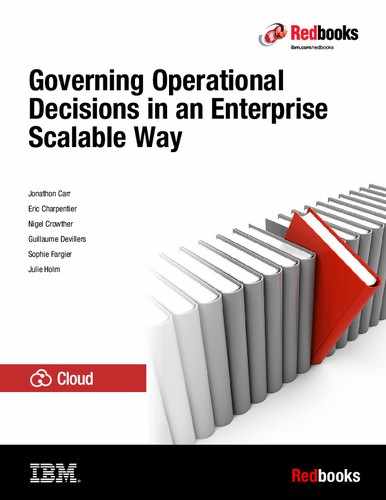

Conclusion
This IBM Redbooks publication focused on the governance of operational decisions within the enterprise. We explained how to configure IBM Operational Decision Manager (ODM) to enable safe yet agile change to business policies. We explained that the difference between IT Governance and decision governance is that decision governance puts the power of change into the hands of the business. This enables agility and ultimately a more agile, reactive, and competitive organization.
Because decision governance requires more collaboration between IT and business, in Chapter 2, “Decision governance for project managers” on page 9, we provided guidance to help organizations manage decision governance projects. Then in Chapter 3, “Roles and responsibilities in governing decisions” on page 21 we took a detailed look at the roles required for decision governance.
Chapter 4, “Securing the Decision Center” on page 31 explained how to create the roles and users described in Chapter 3, “Roles and responsibilities in governing decisions” on page 21. It also described how to assign the appropriate permissions to be able to perform their duties.
Chapter 5, “Designing decision services” on page 61 provided leading practice implementation suggestions so that the artifacts within a decision service can be managed in a scalable way.
Chapter 6, “Processes” on page 73 described the processes for business and IT change. It explained that IT-centric processes describe the governance of change by technical users and Business-centric processes describe the governance of change by business users.
Chapter 7, “Decision governance framework” on page 85 provided a detailed look at the built-in framework for Business-centric changes within ODM.
Chapter 8, “Deployment” on page 119 detailed the IT-centric and Business-centric approaches to deployment, and discussed the concept of two-phase deployment that can be used when Decision Center Rule Execution Server are disconnected.
Chapter 9, “ODM DevOps” on page 127 described how the content in Chapter 6, “Processes” on page 73, Chapter 7, “Decision governance framework” on page 85 and Chapter 8, “Deployment” on page 119 can be automated using ODM APIs.
Chapter 10, “ODM on Cloud” on page 135 looked under the covers of IBM’s cloud solution for ODM.
Finally, Chapter 11, “Branching and merging” on page 143 explained how to use the advanced repository management features of Decision Center when the decision governance framework is not used.
12.1 Where you go from here
This book provided leading practice governance suggestions and process templates that can be tailored for a governance solution that works in your company.
Once your governance solution is up and running, it is important to elicit feedback from users of the governance processes. Maturity and experience build over time, and capturing feedback will help improve the solution. Additionally, IBM is continuously releasing new versions of the product. It is important to make a cost/benefit analysis on the cost of upgrading versus the benefit of new features that will make your governance solution more streamlined.
In Chapter 2, “Decision governance for project managers” on page 9 we talked about setting up a Center of Excellence (CoE). The first users will be the ODM pioneers who will be the champions supporting the next project. After a few projects, the pioneers will develop a community to share ODM leading practices and patterns. The funding would initially come out of individual projects, but eventually there might be a specifically funded role to lead the CoE. The CoE would then become a group of SMEs enabling agile business policy change throughout the organization.
..................Content has been hidden....................
You can't read the all page of ebook, please click here login for view all page.
